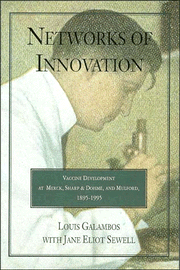Book contents
- Frontmatter
- Contents
- PREFACE
- 1 1894: “The foremost medical question of the day”
- 2 The Mulford Story
- 3 A Sharp & Dohme Interlude
- 4 The Virology Network and a New Program at Merck Sharp & Dohme
- 5 Hilleman's Innovations: First Phase
- 6 Dangerous Interlude
- 7 Transforming Bacteriology: A Second Phase
- 8 New Networks, New Leadership: The Hepatitis B Vaccines
- 9 Vaccine Innovation in the Nineties: New Strategies, New Opportunities, and Public Confrontations
- 10 Historical Perspectives on the Process of Innovation
- ACKNOWLEDGMENTS
- A WORD ABOUT SOURCES
- INDEX
- Plate section
8 - New Networks, New Leadership: The Hepatitis B Vaccines
Published online by Cambridge University Press: 06 July 2010
- Frontmatter
- Contents
- PREFACE
- 1 1894: “The foremost medical question of the day”
- 2 The Mulford Story
- 3 A Sharp & Dohme Interlude
- 4 The Virology Network and a New Program at Merck Sharp & Dohme
- 5 Hilleman's Innovations: First Phase
- 6 Dangerous Interlude
- 7 Transforming Bacteriology: A Second Phase
- 8 New Networks, New Leadership: The Hepatitis B Vaccines
- 9 Vaccine Innovation in the Nineties: New Strategies, New Opportunities, and Public Confrontations
- 10 Historical Perspectives on the Process of Innovation
- ACKNOWLEDGMENTS
- A WORD ABOUT SOURCES
- INDEX
- Plate section
Summary
WHILE Virus and Cell Biology was developing new capabilities in bacterial vaccines, the department and Maurice Hilleman, its lead scientist for more than twenty-five years, had continued to explore the opportunities for new vaccines against viral infections.’ One of the most important of these was hepatitis B (HBV), a virus with perhaps as many as 300 million long-term carriers around the world. The first phase of this project lasted for thirteen years (1968–81) and the second, overlapping phase for eleven years (1975–86). This second phase of research and development carried Merck into contact with new scientific networks and forced the firm to develop entirely new capabilities. This transition took place against the backdrop of dramatic changes in leadership: in Virus and Cell Biology; at the Merck Sharp & Dohme Research Laboratories and at the top of the corporation.
Substantial transitions in executive and scientific leadership can easily disrupt an organization's innovative process. This is especially true when a dominant leader like Hilleman has played a central role in creating and developing the company's scientific and technical capabilities. Customary patterns of teamwork are disturbed. The informal hierarchy that makes innovative organizations run successfully is disrupted, as are the important relationships to the external networks from which the business draws ideas, resources, and support. As we saw in the previous chapters, those relationships had important personal dimensions that were not easy to duplicate. In the worst-case scenario, a transformation in leadership can bring an end to a long cycle of successful innovation of the sort that had characterized the vaccine operations at Merck since the early 1960s.
- Type
- Chapter
- Information
- Networks of InnovationVaccine Development at Merck, Sharp and Dohme, and Mulford, 1895–1995, pp. 181 - 210Publisher: Cambridge University PressPrint publication year: 1996



